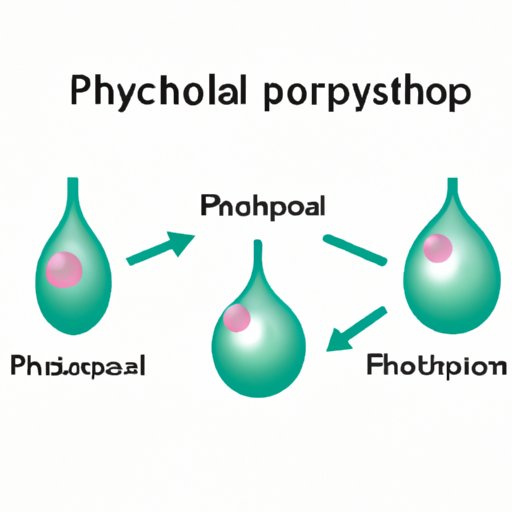Exploring which part of the phospholipid is hydrophobic
Phospholipids are an important building block of cell membranes. These molecules have a hydrophilic (water-attracting) head and a hydrophobic (water-repelling) tail. However, many people are confused about which part of phospholipids is hydrophobic. In this article, we will explore the structure of phospholipids, why their tails are hydrophobic, and how this property is essential for cell membrane function. We will also examine how the length and saturation of fatty acid chains affect the fluidity of the membrane and its impact on overall cell function.
Exploring the Hydrophobic Nature of Phospholipids: An In-Depth Analysis of Their Structure
A phospholipid is composed of one hydrophilic head and two hydrophobic tails. The head contains a phosphate group, which is charged and polar, making it attracted to water molecules. The tails are composed of fatty acid chains that are long, nonpolar, and not attracted to water molecules.
Phospholipids are arranged with their heads facing the water-based interior and exterior of the cell and their tails forming a double layer in the membrane interior. This arrangement is essential for the stability and function of the cell membrane.
Why Phospholipid Tails Are Hydrophobic and What It Means for Cell Membrane Function
The hydrophobicity of phospholipid tails is a result of the chemical properties of fatty acids. Fatty acids are long hydrocarbon chains consisting of carbon and hydrogen atoms. Carbon and hydrogen have similar electronegativity, meaning the electrons are evenly distributed in the molecule, creating a nonpolar bond.
Water is a polar molecule because it has a partial negative and positive charge. Due to their nonpolar nature, the fatty acid tails are not attracted to water molecules, which confers the membrane hydrophobic properties.
The hydrophobic tails of phospholipids interact with each other through weak van der Waals forces, causing the membrane to form a stable, cohesive structure. The hydrophobic interior of the membrane creates a barrier that allows the cell to selectively regulate the exchange of molecules with the extracellular environment.
Getting to Know Your Phospholipids: A Spotlight on Their Hydrophobic Fatty Acid Chains
Phospholipids are composed of two fatty acid chains. The length and saturation of these chains affect the fluidity of the membrane. A longer chain causes increased hydrophobic interactions between the chains and a decrease in membrane fluidity. Conversely, a shorter chain causes weaker interactions and increased membrane fluidity.
Saturation affects membrane fluidity. Saturated chains are straight and pack tightly together, causing the membrane to be more rigid and less fluid. On the other hand, unsaturated chains such as cis double bonds introduce a kink in the chain, disrupting the tight packing and increasing membrane fluidity.
The fluidity of the membrane impacts the function of membrane-bound proteins by altering the permeability and stability of the membrane.
The Science of Hydrophobicity: How Phospholipid Molecules Repel Water and Maintain Membrane Integrity
Hydrophobicity arises from the way in which the electron cloud, generated by a molecule’s atoms and their charges, interacts with those of neighbouring water molecules. Polar molecules have uneven distributions of charge, creating a positive and negative pole within the molecule. When polar molecules come into contact with water, their poles react with the opposite poles in water molecules. This reaction can cause the breakdown of Van der Waals and hydrogen bonds and create stable bond structures.
Hydrophobic molecules, on the other hand, contain nonpolar covalent bonds with an even electron distribution that doesn’t interact well with a molecule with polarity like water. Whenever possible, hydrophobic molecules stay away from water to avoid the uneven charge-induced instability that occurs. As a result of the nonpolar interactions between the fatty acid chains of the phospholipids, the hydrophobic interior of the membrane is maintained, promoting membrane integrity.
Hydrophilic Head, Hydrophobic Tail: How Phospholipids Keep Cells Safe and Sound
The hydrophilic head and hydrophobic tail of phospholipids work together to allow the cell membrane to serve its functions. Membranes separate the cell content from the outside environment and give cells their own unique identity. Membranes also enable cell communication as they are essential for the movement of molecules across the membrane and controlling the chemical composition of the cell.
Analogy- To give the example of a water droplet on a windshield, the outer facing layer of the drop is hydrophilic, and the inner-facing layer is hydrophobic. It causes a cohesive liquid droplet that rolls down the surface of a windshield until the adhesion force is cleared, carrying the dirt and debris away with it. The same principle applies to the membrane of a cell, where the hydrophilic and hydrophobic regions operate together to give a cohesive structure to the cell’s membrane.
Demystifying the Hydrophobic Properties of Phospholipids: A Beginner’s Guide to Membrane Biology
The hydrophobic properties of phospholipids are essential for the structural integrity and function of the cell membrane. Understanding the importance of the hydrophobic interior of the membrane and the factors that affect membrane fluidity is vital to comprehend the role of the cell membrane in cell function.
Learning the concepts described helps create a fundamental understanding of the fundamentals of membrane biology. It conjoins to give the first step in understanding how a cell’s tiny components work together to create something much more complex and intricate, enabling us to gain a deeper understanding of the human body and its functions.
Conclusion
Phospholipids are essential components in cell membranes, and their hydrophobic tails are critical to the integrity of the membrane. By maintaining the membrane’s structural integrity and regulating the exchange of substances with the extracellular environment, phospholipids support the cell’s survival and function.
The structure and function of cell membranes are essential topics in biological study. By understanding the hydrophilic head and hydrophobic tails of phospholipids, their interactions, and their role in regulating membrane fluidity, you can gain a more in-depth comprehension of the complex system that is a living cell.
Thank you for reading. Please leave feedback and share with individuals who may benefit from this article.
